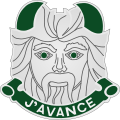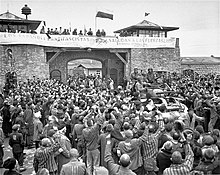11th Armored Division (United States)
This article needs additional citations for verification. (July 2012) |
| 11th Armored Division | |
|---|---|
Armor | |
| Role | Armored warfare |
| Size | Division |
| Nickname(s) | "Thunderbolt" |
| Motto(s) | J'Avance (I Advance) |
| Engagements | World War II
|
| Commanders | |
| Notable commanders | Edward H. Brooks |
| Insignia | |
| Distinctive unit insignia |  |
| U.S. Armored Divisions | ||||
|
The 11th Armored Division (11 AD) was a
The 11 AD landed in France on 16 December 1944, crossed into Belgium on 29 December, and entered Germany on 5 March 1945. The 11th Armored Division was disbanded in August 1945.
Commanders
Commanders of the 11th Armored Division were:[1]
- Major General Edward H. Brooks, August 1942 – March 1944
- Brigadier General Charles S. Kilburn, March 1944 – March 1945
- Brigadier General (later Major General) Holmes E. Dager, March 1945 – May 1945
Combat chronicle
The division was activated on 15 August 1942. It arrived in England 11 October 1944 and prepared for combat with two months' training on the
An eyewitness account by John Fague of B Company, 21st Armored Infantry Battalion of the 11th Armored Division, describes the killing of 80 German prisoners by American soldiers at the Chenogne massacre "Machine guns were being set up. These boys were to be machine gunned and murdered. We were committing the same crimes we were now accusing the Japanese and Germans of doing".[2]
The division acted as spearhead of a wedge into the enemy line, and its junction with the
After a brief rest, the division crossed the
After rest and maintenance, the division drove across the Rhine at

On 5 May 1945, elements of the US 11th Armored Division liberated the
The war in Europe officially ended 9 May, and the division was placed on occupational duty until it was disbanded on 31 August 1945.[3]
Composition
The division was composed of the following units:[4]
- Headquarters
- Headquarters Company
- Combat Command A
- Combat Command B
- Combat Command Reserve
- 22nd Tank Battalion
- 41st Tank Battalion
- 42nd Tank Battalion
- 21st Armored Infantry Battalion
- 55th Armored Infantry Battalion
- 63rd Armored Infantry Battalion
- Headquarters and Headquarters Battery, 11th Armored Division Artillery
- 490th Armored Field Artillery Battalion
- 491st Armored Field Artillery Battalion
- 492nd Armored Field Artillery Battalion
- 41st Cavalry Reconnaissance Squadron (Mechanized)
- 56th Armored Engineer Battalion
- 151st Armored Signal Company
- Headquarters and Headquarters Company, 11th Armored Division Trains
- 133rd Ordnance Maintenance Battalion
- 81st Armored Medical Battalion
- Military Police Platoon
- Band
Casualties
- Total battle casualties: 2,877[5]
- Killed in action: 432[6]
- Wounded in action: 2,394[7]
- Missing in action: 11[8]
- Prisoner of war: 40[9]
References
- ^ "Combat Chronicle: Commanders". 11th Armored Division. Washington, DC: U.S. Army Center of Military History. Retrieved 31 January 2021.
- ISBN 978-0-275-99300-9.
- ISBN 0-253-10982-5.
- ^ "Order of Battle of the US Army - WWII - ETO - 11th Armored Division". US Army Center of Military History. Retrieved 22 May 2020.
- ^ Army Battle Casualties and Nonbattle Deaths, Final Report (Statistics and Accounting Branch, Office of the Adjutant General, 1 June 1953)
- ^ Army Battle Casualties and Nonbattle Deaths, Final Report (Statistics and Accounting Branch, Office of the Adjutant General, 1 June 1953)
- ^ Army Battle Casualties and Nonbattle Deaths, Final Report (Statistics and Accounting Branch, Office of the Adjutant General, 1 June 1953)
- ^ Army Battle Casualties and Nonbattle Deaths, Final Report (Statistics and Accounting Branch, Office of the Adjutant General, 1 June 1953)
- ^ Army Battle Casualties and Nonbattle Deaths, Final Report (Statistics and Accounting Branch, Office of the Adjutant General, 1 June 1953)
External links
- European Center of Military History Order of Battle 11th Armd Division
- Thunderbolt: The Story of the 11th Armored Division (World War II unit history booklet)
- The 11th Armored Division Association
- Fact Sheet of the 11th Armored Division from http://www.battleofthebulge.org
- Hartman, J. Ted. Tank Driver: With the 11th Armored from the Battle of the Bulge to VE Day. Bloomington: Indiana University Press, 2014.
